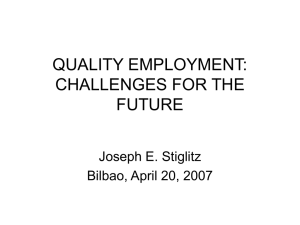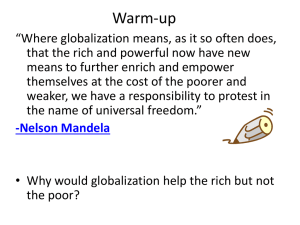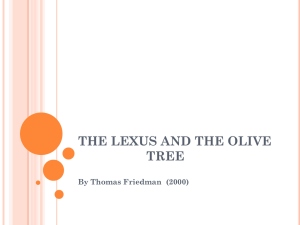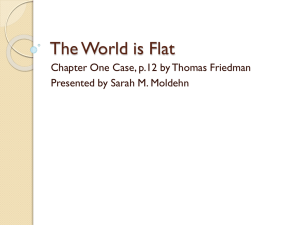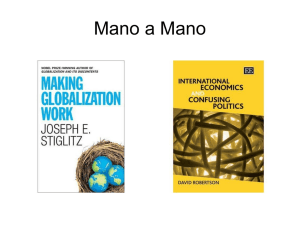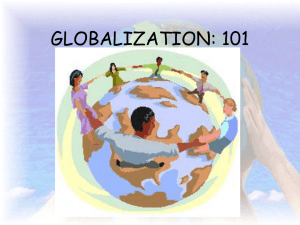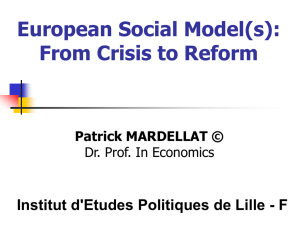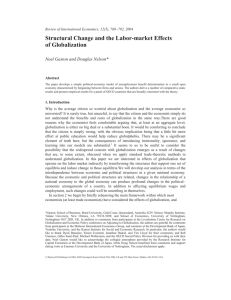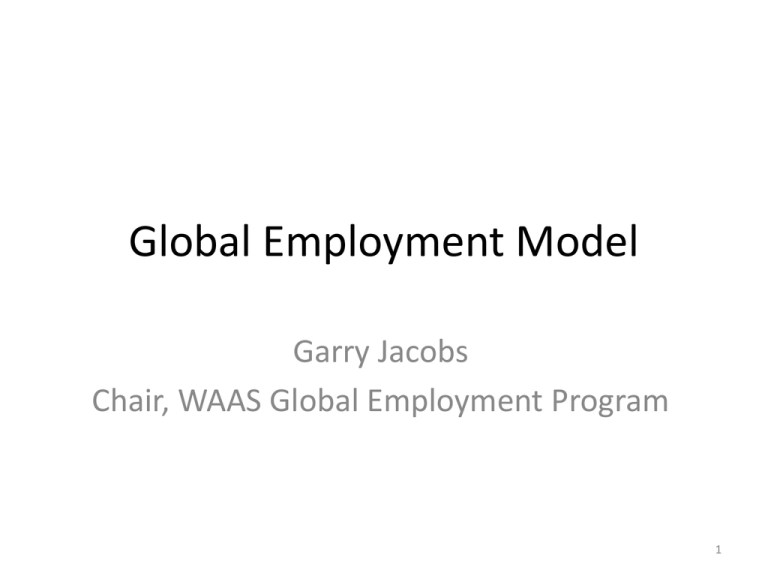
Global Employment Model
Garry Jacobs
Chair, WAAS Global Employment Program
1
Factors Impacting Employment
1.
2.
3.
4.
5.
6.
7.
8.
9.
10.
11.
12.
13.
14.
15.
16.
Demography: population growth and increasing life expectancy *
Transformation of work: from agriculture to manufacturing to services *
Mechanization and automation *
Globalization of trade and outsourcing *
Rates of economic growth *
Income distribution *
Patterns of investment – speculative vs. productive *
Increase in quality of jobs *
Higher educational requirements *
International labor mobility *
Labor policies *
Public policies and regulation
Entrepreneurship
Self-employment
Vocational training
Virtualization of work
2
Pop & Employment 1950-2007
10
3.5
9
Population (Billions)
8
2.5
7
6
WAP - 191%
Employment - 233%
2
5
Population - 168%
4
3
1.5
1
2
Employment & WAP (Billions)
3
0.5
1
0
0
Population
Employment
WAP (25-64)
3
Demography
• Trends
–
–
–
–
–
–
–
–
–
Employment growth relative to population and labor market growth
Impact of rising population on global economic demand
Labor market growth in developing countries increases labor supply
Aging of the population in OECD
Greater longevity will push retirement ages higher
Labor shortages are projected in some economically advanced countries
Urbanization
Migration of workers from developing to developed nations
Potential impact of international labor policies such as minimum wage
• Issues
–
–
–
–
–
What will be the impact of aging on labor markets?
Where will it create shortages and to what extent?
How are shortages likely to be filled?
What will be the impact of aging on retirement age?
How will society harness the capabilities of more experienced older workers who
wish to continue working?
– What will be the economic impact on a declining percentage of working age
population on pension and welfare systems?
– How will worker sex ratios change? What factors will most affect them?
4
Economic Growth
• Trends
– Projected national and global economic growth rates and their
impact on total employment
– Rising living standards in emerging markets will create enormous
demand in future
– “Job Exports” –jobs created overseas from domestic growth
– Impact of growth of tourism, medical tourism generate jobs in all
regions
• Issues
– What will be the relative contribution of financial capital,
technology and human capital to future economic growth?
– Income and Employment Multiplier Effects
– Impact of tradeoffs between technology and labor, e.g. farm
employment
– Relationship between economic growth and domestic and
international job creation
5
Globalization of Markets
• Trends
– Growth of manufacturing trade since 1990 shifts jobs
internationally
– Outsourcing of services shifts jobs to developing
countries
– Globalization of Labor Markets/Flows/Labor mobility
– Effects of the unification of the EU market on
employment may be obscured by other factors
• Issues
– To what extent can global markets be regulated
nationally or internationally?
– What are the crucial regulatory decisions that would
have maximum impact on employment?
6
Finance
• Trends
–
–
–
–
–
–
Globalization of financial markets
Growing divorce between finance and economy
Rising unutilized international financial reserves
International capital investment flows
Interest rates
Currency stability and valuation
• Issues
– The role of money and capital and its impact on employment
– What is the public good impact of financial markets
– The huge cost of global financial instability is not being priced – the public is
paying for instability and the right to speculate
• Bailouts
• Instability reduces long term productive investments
• Need for huge unproductive foreign exchange reserves
– Potential impact of policies to reduce non-productive investment and incentivize
productive investments, e.g. Tobin Tax
– Impact of incestuous relationship between major corporations and investment
funds on corporate decisions, including employment
7
Human Capital Formation
• Trends
– Multiplier effect of human capital formation on
economic growth and employment
– Impact of underemployment and unemployment
on Human Capital
– Financial capital vs. human capital
– Investment in human capital formation
8
Education
• Trends
–
–
–
–
–
–
Levels of education are rising dramatically worldwide, e.g. Korea, China
Impact if education on employability
Relationship between education, employment and unemployment.
Relationship between education and income
Labor market educational requirements
Rising levels of education on aspirations, consumption patterns and
effective demand
– Educated unemployment in developing and industrialized countries
– Life-long learning
• Issues
–
–
–
–
–
Educational curriculum and employability
Firewall between universities and labor market in Europe
Why MBAs are more employable?
Accountability of universities
Education and immigration
9
Skills shortage
• Trends
– Emerging skill shortages and skill mismatches in
industrialized and developing countries
– Projecting future skill needs
– Trends in vocational education and training
• Issues
– Alternative training delivery systems
– Education, apprenticeship, employment programs
10
Business Strategy
• Trends
–
–
–
–
Globalization of sourcing and distribution systems
Globalization of business ownership
Globalization of MNC employment strategies
Shift of capital investment to growth markets and low
wage producers
– Shift of production to low wage countries
– Shift of production to fast developing markets
– Outsourcing of services
• Issues
– Reduced effectiveness of national level policies on
business
11
Technology
• Trends
– Dissemination of new products and technologies at all
time high
– Rate of process and product innovation more rapid
than before
– Impact of process and new product development on
employment in manufacturing and services
– Factors influencing the substitution of capital and
technology for labor
• Issues
– Attitudes, policies and business strategies impacting
investment in technology
12
Ecology
• Trends
– Energy prices and their impact on employment vs.
capital investment
– Pressure to change technological base from fossil
fuels creates problems and opportunities
– Pressure to improve energy consumption at a time
of rapid economic growth
13
Getting prices right
•
•
•
•
•
•
Pricing labor and capital
Are we pricing capital correctly?
Pricing to reflect the actual cost of unemployment
Policies to get prices aligned
Pricing of resources
Distinguish between extracting cost and ecological
value of different resources
• Assigning ecological cost of water will dramatically
change agricultural and other prices
14
Social Costs of Unemployment &
Underemployment
• Impact on human capital
• Impact on social capital – neighborhoods,
community
• Impact on social unrest, crime, violence, peace
and stability
15
Emerging economic opportunities
• Historical analysis of the impact of new needs,
products and services on employment
• Project future profile of new services and job
requirements in developing and developed
countries
• Factors influencing new business development
• Scope for less developed nations to adopt services
prevalent in economically advanced nations
• High Potential Industries
• Insurance as a driver – positive causal impact on
economic growth
16
Evolution of Social Organization
• Impact of social organization on new business
opportunities
• Future impact of the Internet on the way work is
carried out
• Social Development and Macro psychology
– Impact of changing social attitudes on growth and
employment
– Trust deficits – their causes and remedies
– Impact of trust on social development, economic
growth and employment
• Potential role of new types of insurance to
promote trust, security and development
17
Law, Human Rights & employment
•
•
•
•
Law and Human rights
Property rights vs. the right to work
The value of human security
The challenge of food security is really about
ensuring access to employment opportunities.
• Social attitudes toward unemployment
18
Public Policy
• Trends
–
–
–
–
–
–
–
Public Sector as a major part of the economy
Policies regulating new job creation
Policies restricting entrepreneurial activity and employment
Public investment in stimulus
Welfare and social security
Employer of last resort programs
Guaranteed basic income – 4 Pillars
• Issues
– Need for political economic theory that reflects the large role of
government in economy
– Reconciling free markets with public good
– Vested interests of financial markets and investors impacting employment
policies
– Public investment to crowd in private insurance, e.g. New Orleans
– Reliance on classical macroeconomic strategies to address employment
19
20
India – China GDP Growth (PPP)
21
India – China GDP Growth (Market)
22

